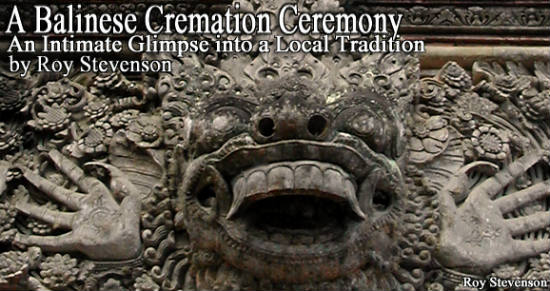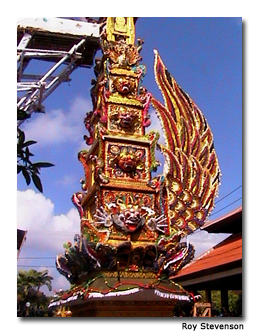

The loud, rhythmic sounds of people chanting and drumming and the sight of hundreds of others dressed in multi-colored batik sarongs and swirling skirts are overwhelming.
Sensory overload sets in from the bright sunshine, suffocating heat and humidity, and sweet perfumed smell of flowers and incense wafting across the potholed, asphalt road.
Standing on the brown dirt path at the roadside, I’m stunned and bewildered as I look out at this melee of activity. Feeling self-conscious about intruding on such a personal scene I look around to see only a handful of other tourists hovering on the periphery.
A short old man, wizened by the sun, smiles and beckons me into a nearby open hut. He places a folded brown-colored cotton band around my head and a bright red and green batik sari around my waist.
He says, “Welcome to our cremation ceremony,” then leads me back out into the sweaty throng of Balinese villagers who are preparing for the procession.
A body wrapped in a white shroud is brought out of the wooden slatted village leader’s house, carried shoulder high along a dirt pathway and placed in a black coffin. White flower petals thrown by mourners descend on the coffin as it is borne to a 30-foot-high (9.1 meters) pagoda-like tower standing nearby on the road.
Passed carefully from hand to hand, the coffin is lifted up the tower by young men of the village. The coffin ascends the tower in stages, as some of the wiry and muscular men climb past it to the next level to receive it again. Eventually it is placed into a dark recess halfway up the glittering red and gold decorated tower.
The mourning family looks solemn, but members occasionally smile and wave to their friends. It’s not the typical weeping, grief-stricken scene experienced at a western funeral. The family walks in front of the tower as it’s slowly pushed and pulled along the hot dusty road by over a dozen strong young men. We head through the small ramshackle village, down the slight grade toward the cremation grounds a half-mile away.
Resting on four enormous black rubber tires, each the size of a man, the tower is so tall it was necessary to remove the overhead power lines. Hundreds of people follow, some silent, some talking and some singing. I join the throng, slowly walking with the crowd.
Balinese Hindu cremation ceremonies are among the most renowned cultural activities in the world for adhering to their ancient roots, dating back over a thousand years. The notable exception that has broken with ancient tradition: wives of the deceased no longer throw themselves onto the blazing funeral pyres as their dead husbands are cremated.
Much of Bali’s strongly preserved cultural heritage is intertwined with the funeral ceremonies. Its fascinating cultural traditions include traces of many religions and cults including Islam, Hinduism, Buddhism, Christianity, animism, magic and spirits, with hundreds of accompanying gods and demons.
Evidence of these ancient beliefs is preserved in the stone carvings of fierce-looking masks, fangs protruding, that adorn the two or three temples found in every small village. Temple rituals also reflect these beliefs.

But nowhere is evidence of these religions as strong as in Balinese cremation ceremonies. The ceremonies are quite rare and are the focus of tremendous activity by the villagers for weeks beforehand. The tower must be built, with ornate and colorful decorations to adorn it.
A huge fierce-looking black bull or water buffalo in which the coffin is ultimately deposited for cremation has to be created by a specialized craftsman.
The families of the deceased often spend their life savings on the ceremony fixtures, as Balinese culture considers it disgraceful not to do it right. After all, the deceased is going on to a far better place and it is the responsibility of the family to ensure this happens with utmost comfort, ceremony and respect.
We near the cremation area, a large uneven grassy area with a patchwork of small stands of tall palm trees and bright green jungle foliage. The tower grinds to a halt and the coffin is transferred respectfully into the large matching hole in the back of a seven-foot (2.1 meter) tall fierce-looking black and gold painted bull.
The bull is wheeled onto the unlit funeral pyre consisting of thick criss-crossed palm tree trunks. Brief speeches are made, followed by chants. Then, what looks like a cross between a hot-air balloon air heater and a World War II flame-thrower is fired up and aimed at the bull. A 12-foot (3.6 meter) jet of red and yellow flame spurts out.
“It gets up to 2,000 degrees”, a Balinese man tells me, as we stand back from the rapidly expanding heat wave, watching the palm logs catch fire. The crowd stands motionless, mesmerized, watching, as the flame turns blue with the heat, the bull starting to blister and burn.
Elsewhere around the burial grounds families spread out among the final resting places of their loved ones, cleaning up around the simple graves. They lay down brightly colored blankets and straw mats, unpacking food and drink. They place small woven baskets of flowers as offerings on the gravesites of their deceased, and then pray to them.
That done, they sit around, laughing, talking and eating, while the children run around, chasing and hiding from each other. Balinese cremations are not a sad event, rather they are a remembrance of friends and family who are no longer here, and even display joy that the loved ones are in a better place.
Hours later, as the shadows grow long and dark, the villagers slowly start to disappear, leaving a few people watching the red hot ashes, what is left of the bull and the body.
Hypnotized and emotionally drained, I look up from the ashes and realize that staying longer might be imposing on this final ritual. I slowly wander back to the village to find a cab. I look over my shoulder at a sight that I know I will never see again.
The slowly dispersing people, the plume of smoke, and the red glowing ashes are my last vision of this memorable event.
If You Go
Bali’s Visitor Site
Roy Stevenson is a freelance writer based in Seattle, Washington. He writes on travel, military history, sports, fitness, and film festival reviews. He can be reached for comment at [email protected].
